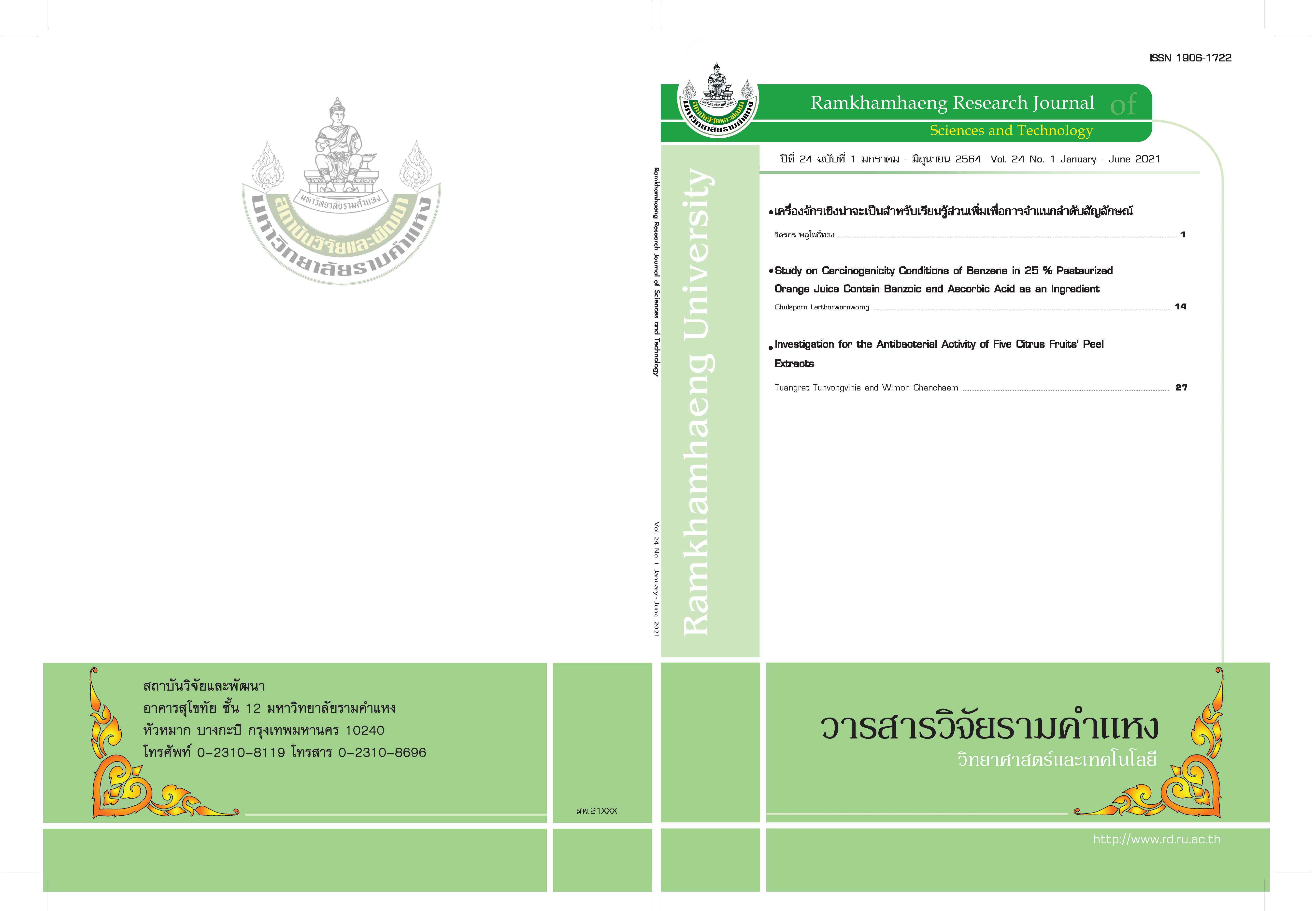Investigation for the Antibacterial Activity of Five Citrus Fruits’ Peel Extracts
Main Article Content
Abstract
Bacterial infections are very important problems of world population. Many countries have to pay large budgets dealing with these diseases. However, there were lots of studies currently reported that fruits and folk plants were rich sources of medicinal compounds those have high potential as antimicrobial agents for alternative treatments. In this study, fruit peels of five citrus fruits including Citrus maxima, Citrus reticulata Blanco, Citrus reticulata Blanco cv. Sainampueng, Citrus hystrix DC and Citrus aurantifolia were extracted by using four methods including boiling, maceration in absolute ethanol, blending of fruit peels powder in water and blending of fresh fruit peels in water. The antibacterial activities of citrus fruits’ peels were evaluated using the agar disk diffusion method towards Escherichia coli, Staphylococcus aureus and Pseudomonas aeruginosa. The results showed that crude extracts of these five fruits’peels from ethanolic extraction had antibacterial activity to S. aureus and those using dry powder blending extraction had antibacterial activity to P. aeruginosa. No inhibition zone was found in all five extracts that used boiling extraction and fresh peel blending extraction.This study also showed that the activities of those extracts depended on many factors such as species of fruits, solvent, and the method of extraction. This preliminary study demonstrated that these citrus fruits’ peels contained some interesting levels of antibacterial components. Further study for the type and quantity of those important substances should be performed. This will lead to proper applications in pharmaceuticals or other antimicrobial products in future.
Article Details
Ramkhamhaeng University
References
Barco, L., Ramon, E., Cortini, E., Longo, A., DallaPozza, M.C., Lettini, A.A., et al. 2014. Molecular characterization of Salmonella enterica serotype 4,[5],12:I :-DT193 ASSuT strains from two outbreaks in Italy. Foodborne Pathog Dis. 11(2): 138-144.
Bengtsson-Palme, J., Kristiansson, E., Joakim Larsson, D.G. 2018. Environmental factors influencing the development and spread of antibiotic resistance. FEMS Microbiol Rev. 42(1): 68-80.
Bloch, S.K, Felczykowska, A., Nejman-Falenezyk, B. 2012. Escherichia coli O104: H4 outbreak: have we learnt a lesson from it. ActaBiochem Pol. 59(4): 483-488
Campion, J.J., McNamara, P.J., Evans, M.F. 2004. Evaluation of ciprofloxacin-resistant Staphylococcus aureus in in vitro pharmacokinetic environment. Antimicrob Agents Chemother. 48(12): 4733-4744.
Chen, G.W., Lin, Y.H., Lin, C.H., Jen, H.C. 2018. Antibacterial activity of emulsified Pomelo (Citrus grandis Osbeck) peel oil and water soluble Chitosan on Staphylococcus aureus and Escherichia coli. Molecules.23: 840.doi: 10.3390/ molecules 23040840.
Clinical and Laboratory Standards Institute [CLSI]. 2012. Reference method for dilution antimicrobial susceptibility test for bacterial that grow aerobically. Approved Standard M7-A6.National Committee for Clinical and Laboratory Standards. Wayne, Penn, USA.
Choi, M.J., Jackson, K.A., Medus, C., Beal, J., Rigdon, C.E., Cloyd, T.C., et al. 2014. Notes from the fields: multistage outbreak of listeriosis linked to soft-ripened cheese - United States 2013. Morb Motal Wkly Rep. 63(13): 294-295
Levy, S.B., Marshall, B. 2004. Antibacterial resistance worldwide: causes, challenges and responses. Nat Med. 10:S122-S129.
Makni, M., Jemai, R., Kriaa, W., Chtourou, Y., Fetoui, H. 2018. Citrus limon from Tunisia: Phytochemical and Physicochemical properties and Biological activities. BioMed Research International. Article ID 6251546.
Panda, S.K., Mohanta, Y.K., Padhi, L., Park, Y.H., Mohanta, T.K., Bae, H. 2016. Large scale screening of ethnomedical plants for identification of potential antibacterial compounds. Molecules. 21(293): 1-20.
Ramadan, E.M., Abou-Taleb, K.A., Galal, G.F., Abdel-Hamid, N.S. 2017. Antibacterial, antibiofilm and antitumor activities of grape and mulberry leaves ethanolic extracts towards bacterial clinical strains. Ann Agric Sci. 62:151-159.
Ranibar, R., Dehkordi, F.S., Shahreza, M.H.S., Rahimi, E. 2018. Prevalence, identification of virulence factors, O-serogroups and antibiotic resistance properties of Shiga-toxin producing Escherichia coli strains isolated from raw milk and traditional dairy products. Antimicrobial Resistance and Infection Control. 7:53.doi http//:doi.org/10.1186/s13756-018-0345-x.
Sharma, C., Rokana, N., Chandra, M., Singh, B.P., Gulhane, R.D., Gill, J.P.S., et al. 2018. Antibacterial resistance: Its surveillance, impact, and alternative management strategies in dairy animals. Frontiers in Veterinary Science. 4:237. doi:10.3389/fvets.2017.00237.
Tagel, A.A., Shaban, S.M., Moussa, S.H., Elguindy, N.M, Diab, A.M., Mazrou, K.E., et al. 2018. Bioactivity and application of plant seeds’ extracts to fight resistant strains of Staphylococcus aureus. Ann Agric Sci. 63: 47-53.
Tayel, A.A., Abdel Monem, O.A., Moussa, S.H., Al Turki, A.I. 2013. Plant extracts as antimicrobials: prospects in food safety and health protection, In: Gionano, A., Costs, A. editors. Plant Extracts: Role in Agriculture, Health Effects and Medical Applications. NewYork: Nova Science Publishers, p 311-326.
Van Vuuren, S. and Holl, D. 2017. Antimicrobial natural product research: a review from a South African perspective for the year 2009-2016. J Enthnopharmacol. 208: 236-252.
World Health Organization [WHO]. 2014. Antimicrobial resistance: Global report on surveillance 2014. Geneva, Switzerland: WHO.


